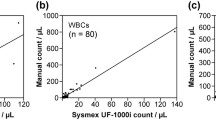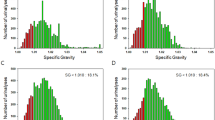Abstract
Urine samples from 100 children and adolescents with micro-or macrohaematuria were investigated using phase contrast microscopy to establish the percentage of G1-cells that could differentiate glomerular from non-glomerular haematuria. The G1-cell is a special form of dysmorphic erythrocyte which seems to be specific for glomerular haematuria. Glomerular haematuria, defined by clinical criteria from biopsy, physical examination, standard laboratory evaluation and family history, was observed in 51 patients (group 1). Non-glomerular haematuria was found in 49 patients (group 2). The latter group had urinary tract infections, urolithiasis, hypercalciuria or haematuria caused by urological operation or diagnostic procedure. The percentage of dysmorphic erythrocytes differed significantly between the two groups studied (42±3% in group 1 vs. 6±1% in group 2, mean±SEM,P<0.01); there was also a significant difference in G1-cells (19.4±1.7% in group 1 vs. 0.6±0.2% in group 2, mean±SEMP<0.01). When glomerular haematuria was defined on the basis of ≥30% dysmorphic erythrocytes by phase contrast microscopy, sensitivity, specificity and efficiency were 71%, 100% and 85%, respectively. When glomerular haematuria was defined on the basis of ≥5% G1-cells, sensitivity, specificity and efficiency were 100%, 100% and 100%, respectively. The differentiation of glomerular and non-glomerular haematuria in children by determination of G1-cells appears to be more sensitive and efficient than the determination of the percentage of dysmorphic erythrocytes by phase contrast microscopy.
Similar content being viewed by others
References
Vehaskari VM, Rapola J, Koskimies O, Savilathi E, Vilska J, Hallman N (1979) Microscopic hematuria in school children: epidemiology and clinicopathologic evaluation. J Pediatr 95: 676–684
Sayer J, McCarthy MP, Schmidt JD (1990) Identification and significance of dysmorphic vs isomorphic hematuria. J Urol 143: 545–548
Birch DF, Fairley KF (1979) Hematuria: glomerular or non-glomerular? Lancet II: 845–846
Birch DF, Fairley KF (1980) Red cells in the urine. Lancet I: 424
Birch DF, Fairley KF, Whitworh JA, Forbes IK, Fairley JK, Cheshire GR, Ryan GB (1983) Urinary morphology in the diagnosis of glomerular hematuria. Clin Nephrol 20: 78–84
Stapleton FB (1987) Morphology of urinary red blood cells: a simple guide in localising the site of hematuria. Pediatr Clin North Am 34: 561–569
Pillsworth TJ, Haver VM, Abrass CK, Delaney CJ (1987) Differentiation of renal from non-renal hematuria by microscopic examination of erythrocytes in urine. Clin Chem 33: 1791–1995
Hildebrandt F, Fecht A, König B, Brandis M (1988) Exakte Beschreibung nicht-glomerulärer und glomerulärer Erythrozytenformen bei kindlicher Hämaturie. Monatsschr Kinderheilkd 136: 10–16
Fassett RG, Horgan B, Matthew TH (1982) Detection of glomerular bleeding by phase contrast microscopy. Lancet I: 1432–1434
Fairley KF, Birch DF (1982) Hematuria: a simple method for identifying glomerular bleeding. Kidney Int 21: 105–108
Offringa M, Benbassat J (1992) The value of urinary red cell shape in the diagnosis of glomerular and post-glomerular haematuria. A meta-analysis. Postgrad Med J 68: 648–654
Tomita M, Kitamoto Y, Nakayama M, Sato T (1992) A new morphological classification of urinary erythrocytes for differential diagnosis of glomerular hematuria. Clin Nephrol 37: 84–89
Fassett RG, Horgan B, Gove D, Mathew TH (1983) Scanning electron microscopy of glomerular and non glomerular red blood cells. Clin Nephrol 20: 11–16
Chu YD, Kitamoto Y, Tomita M, Nakayama M, Sato T (1990) Differentiation of hematuria by differential interference microscopy with a simple criterion. Kumamoto Med J 42: 63–71
Hauglustaine D, Bollens W, Michielsen P (1982) Detection of glomerular bleeding using a simple staining method for light microscopy (letter). Lancet II: 761
Raman GV, Pead L, Lee HA, Maskell R (1986) A blind controlled trial of phase-contrast microscopy by two observers for evaluating the source of hematuria. Nephron 44: 304–308
Crompton CH, Ward PB, Hewitt IK (1993) The use of urinary red cell morphology to determine the source of hematuria in children. Clin Nephrol 39: 44–49
Rizzoni G, Braggion F, Zacchello G (1983) Evaluation of glomerular and non-glomerular hematuria by phase-contrast microscopy. J Pediatr 103: 370–374
Pollock C, Pei-Ling L, Györy KZ, Grigg R, Gallery EDM, Caterson R, Ibels L, Nahony J, Waugh D (1989) Dysmorphism of urinary red blood cells. Value in diagnosis. Kidney Int 36: 1045–1049
Shichiri M, Nishio Y, Oowada A, Tomita K, Shiigai T (1986) Use of autoanalyser to examine urinary-red-cell morphology in the diagnosis of glomerular hematuria. Lancet II: 781–782
Lettgen B, Hestermann C, Rascher W (1994) Differentiation of glomerular and non-glomerular hematuria in children by measurement of mean corpuscular volume of urinary red cells using a semi-automated cell counter. Acta Paediatr 83: 946–949
Kitamoto Y, Tomita M, Akamine M, Inoue T, Itoh J, Takamori H, Sato T (1993) Differentiation of hematuria using a uniquely shaped red cell. Nephron 64: 32–36
Köhler H, Wandel E, Brunck B (1991) Acanthocyturia — a characteristic marker for glomerular bleeding. Kidney Int 40: 115–120
Kitamoto Y, Yide C, Tomita M, Sato T (1992) The mechanism of glomerular dysmorphic red cell formation in the kidney. Tohoku J Exp Med 167: 93–105
Author information
Authors and Affiliations
Rights and permissions
About this article
Cite this article
Lettgen, B., Wohlmuth, A. Validity of G1-cells in the differentiation between glomerular and non-glomerular haematuria in children. Pediatr Nephrol 9, 435–437 (1995). https://doi.org/10.1007/BF00866720
Received:
Revised:
Accepted:
Issue Date:
DOI: https://doi.org/10.1007/BF00866720




